Report on Managing Diversity and Equal Opportunity in the Workplace
VerifiedAdded on 2020/01/07
|9
|2861
|135
Report
AI Summary
This report provides a comprehensive overview of managing diversity and equal opportunity in the workplace. It begins by defining discrimination and exploring various types, including direct and indirect discrimination, harassment, and victimisation, referencing the Equality Act 2010. The report then delves into disability issues, analyzing how the law protects disabled individuals and promotes equality in areas such as recruitment, terms and conditions, sickness absence, and promotional opportunities. It emphasizes the importance of reasonable adjustments and flexible working hours. The report also highlights the Disability Discrimination Act 1995. The conclusion summarizes key findings and offers recommendations, such as increasing incentives, promoting eligible candidates, and granting sick leave without deduction to foster a more inclusive and equitable work environment for disabled employees.
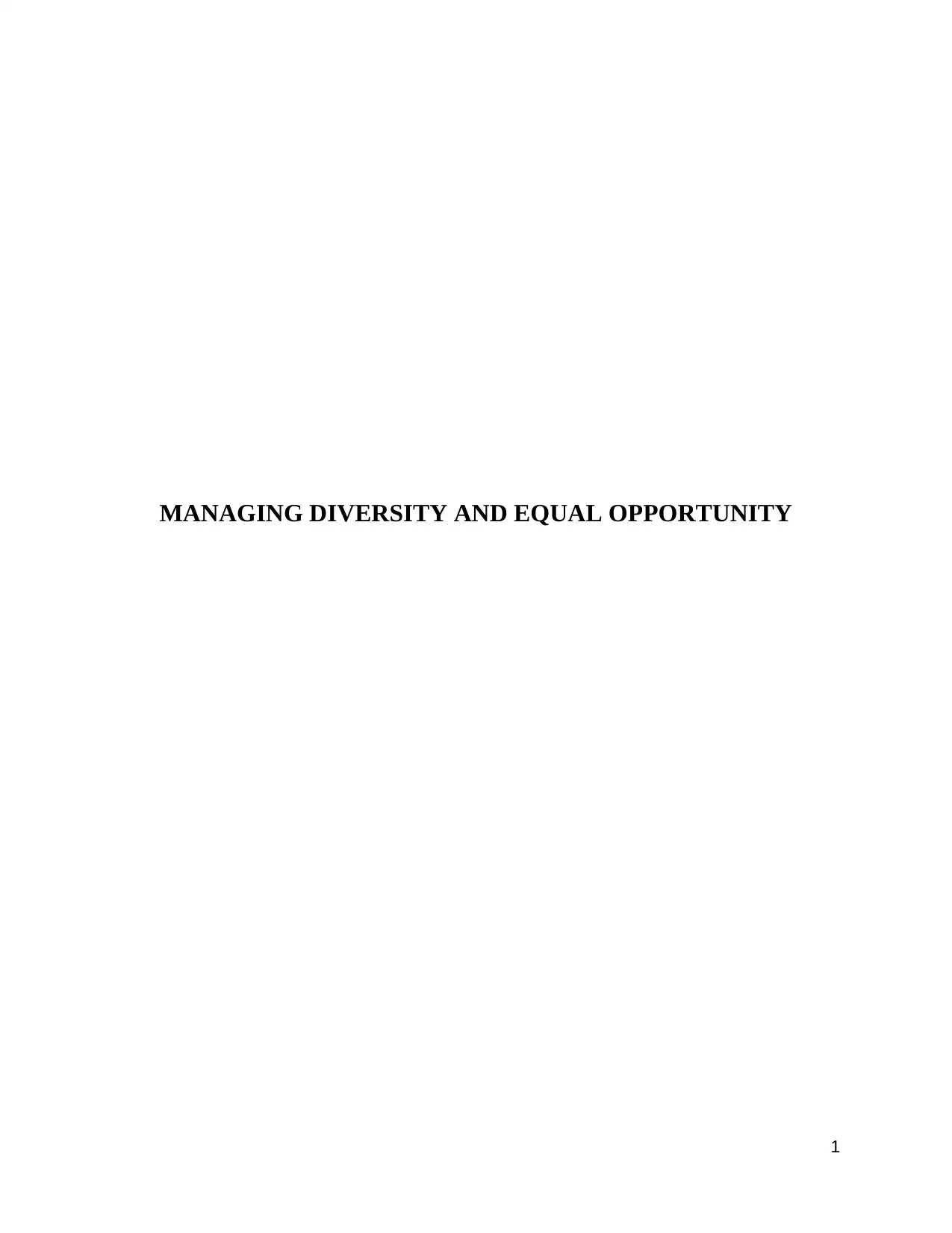
MANAGING DIVERSITY AND EQUAL OPPORTUNITY
1
1
Paraphrase This Document
Need a fresh take? Get an instant paraphrase of this document with our AI Paraphraser
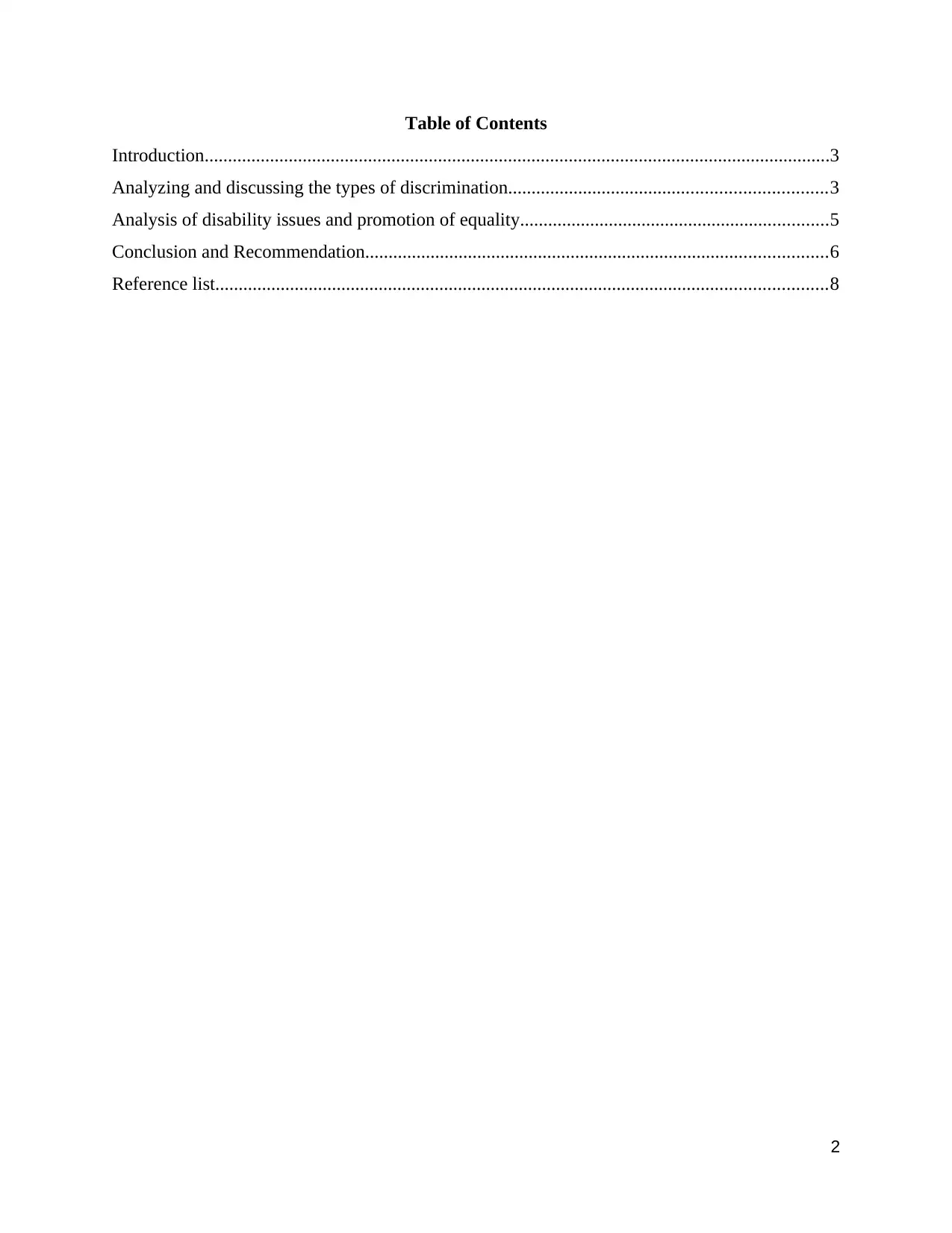
Table of Contents
Introduction......................................................................................................................................3
Analyzing and discussing the types of discrimination....................................................................3
Analysis of disability issues and promotion of equality..................................................................5
Conclusion and Recommendation...................................................................................................6
Reference list...................................................................................................................................8
2
Introduction......................................................................................................................................3
Analyzing and discussing the types of discrimination....................................................................3
Analysis of disability issues and promotion of equality..................................................................5
Conclusion and Recommendation...................................................................................................6
Reference list...................................................................................................................................8
2
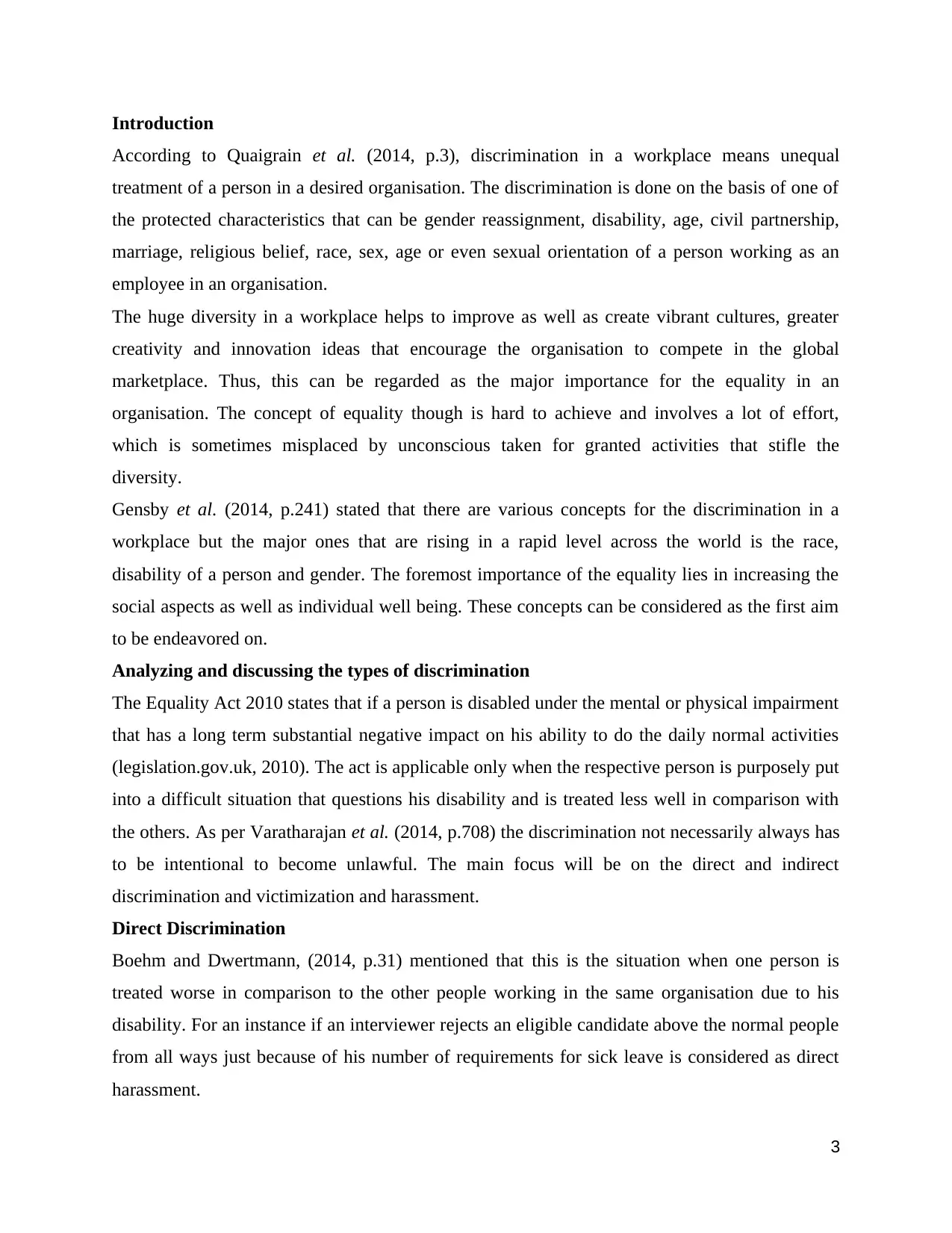
Introduction
According to Quaigrain et al. (2014, p.3), discrimination in a workplace means unequal
treatment of a person in a desired organisation. The discrimination is done on the basis of one of
the protected characteristics that can be gender reassignment, disability, age, civil partnership,
marriage, religious belief, race, sex, age or even sexual orientation of a person working as an
employee in an organisation.
The huge diversity in a workplace helps to improve as well as create vibrant cultures, greater
creativity and innovation ideas that encourage the organisation to compete in the global
marketplace. Thus, this can be regarded as the major importance for the equality in an
organisation. The concept of equality though is hard to achieve and involves a lot of effort,
which is sometimes misplaced by unconscious taken for granted activities that stifle the
diversity.
Gensby et al. (2014, p.241) stated that there are various concepts for the discrimination in a
workplace but the major ones that are rising in a rapid level across the world is the race,
disability of a person and gender. The foremost importance of the equality lies in increasing the
social aspects as well as individual well being. These concepts can be considered as the first aim
to be endeavored on.
Analyzing and discussing the types of discrimination
The Equality Act 2010 states that if a person is disabled under the mental or physical impairment
that has a long term substantial negative impact on his ability to do the daily normal activities
(legislation.gov.uk, 2010). The act is applicable only when the respective person is purposely put
into a difficult situation that questions his disability and is treated less well in comparison with
the others. As per Varatharajan et al. (2014, p.708) the discrimination not necessarily always has
to be intentional to become unlawful. The main focus will be on the direct and indirect
discrimination and victimization and harassment.
Direct Discrimination
Boehm and Dwertmann, (2014, p.31) mentioned that this is the situation when one person is
treated worse in comparison to the other people working in the same organisation due to his
disability. For an instance if an interviewer rejects an eligible candidate above the normal people
from all ways just because of his number of requirements for sick leave is considered as direct
harassment.
3
According to Quaigrain et al. (2014, p.3), discrimination in a workplace means unequal
treatment of a person in a desired organisation. The discrimination is done on the basis of one of
the protected characteristics that can be gender reassignment, disability, age, civil partnership,
marriage, religious belief, race, sex, age or even sexual orientation of a person working as an
employee in an organisation.
The huge diversity in a workplace helps to improve as well as create vibrant cultures, greater
creativity and innovation ideas that encourage the organisation to compete in the global
marketplace. Thus, this can be regarded as the major importance for the equality in an
organisation. The concept of equality though is hard to achieve and involves a lot of effort,
which is sometimes misplaced by unconscious taken for granted activities that stifle the
diversity.
Gensby et al. (2014, p.241) stated that there are various concepts for the discrimination in a
workplace but the major ones that are rising in a rapid level across the world is the race,
disability of a person and gender. The foremost importance of the equality lies in increasing the
social aspects as well as individual well being. These concepts can be considered as the first aim
to be endeavored on.
Analyzing and discussing the types of discrimination
The Equality Act 2010 states that if a person is disabled under the mental or physical impairment
that has a long term substantial negative impact on his ability to do the daily normal activities
(legislation.gov.uk, 2010). The act is applicable only when the respective person is purposely put
into a difficult situation that questions his disability and is treated less well in comparison with
the others. As per Varatharajan et al. (2014, p.708) the discrimination not necessarily always has
to be intentional to become unlawful. The main focus will be on the direct and indirect
discrimination and victimization and harassment.
Direct Discrimination
Boehm and Dwertmann, (2014, p.31) mentioned that this is the situation when one person is
treated worse in comparison to the other people working in the same organisation due to his
disability. For an instance if an interviewer rejects an eligible candidate above the normal people
from all ways just because of his number of requirements for sick leave is considered as direct
harassment.
3
⊘ This is a preview!⊘
Do you want full access?
Subscribe today to unlock all pages.

Trusted by 1+ million students worldwide
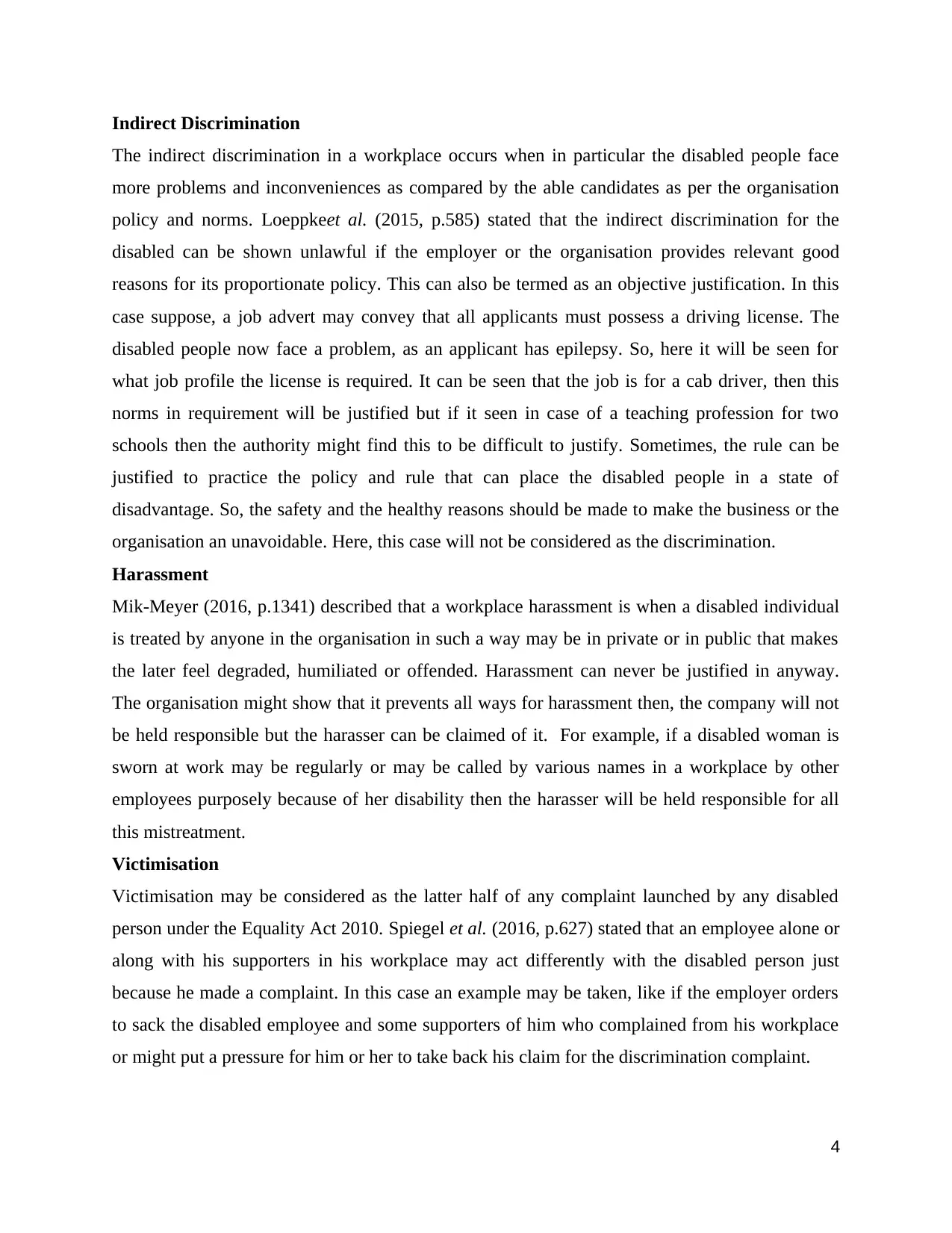
Indirect Discrimination
The indirect discrimination in a workplace occurs when in particular the disabled people face
more problems and inconveniences as compared by the able candidates as per the organisation
policy and norms. Loeppkeet al. (2015, p.585) stated that the indirect discrimination for the
disabled can be shown unlawful if the employer or the organisation provides relevant good
reasons for its proportionate policy. This can also be termed as an objective justification. In this
case suppose, a job advert may convey that all applicants must possess a driving license. The
disabled people now face a problem, as an applicant has epilepsy. So, here it will be seen for
what job profile the license is required. It can be seen that the job is for a cab driver, then this
norms in requirement will be justified but if it seen in case of a teaching profession for two
schools then the authority might find this to be difficult to justify. Sometimes, the rule can be
justified to practice the policy and rule that can place the disabled people in a state of
disadvantage. So, the safety and the healthy reasons should be made to make the business or the
organisation an unavoidable. Here, this case will not be considered as the discrimination.
Harassment
Mik-Meyer (2016, p.1341) described that a workplace harassment is when a disabled individual
is treated by anyone in the organisation in such a way may be in private or in public that makes
the later feel degraded, humiliated or offended. Harassment can never be justified in anyway.
The organisation might show that it prevents all ways for harassment then, the company will not
be held responsible but the harasser can be claimed of it. For example, if a disabled woman is
sworn at work may be regularly or may be called by various names in a workplace by other
employees purposely because of her disability then the harasser will be held responsible for all
this mistreatment.
Victimisation
Victimisation may be considered as the latter half of any complaint launched by any disabled
person under the Equality Act 2010. Spiegel et al. (2016, p.627) stated that an employee alone or
along with his supporters in his workplace may act differently with the disabled person just
because he made a complaint. In this case an example may be taken, like if the employer orders
to sack the disabled employee and some supporters of him who complained from his workplace
or might put a pressure for him or her to take back his claim for the discrimination complaint.
4
The indirect discrimination in a workplace occurs when in particular the disabled people face
more problems and inconveniences as compared by the able candidates as per the organisation
policy and norms. Loeppkeet al. (2015, p.585) stated that the indirect discrimination for the
disabled can be shown unlawful if the employer or the organisation provides relevant good
reasons for its proportionate policy. This can also be termed as an objective justification. In this
case suppose, a job advert may convey that all applicants must possess a driving license. The
disabled people now face a problem, as an applicant has epilepsy. So, here it will be seen for
what job profile the license is required. It can be seen that the job is for a cab driver, then this
norms in requirement will be justified but if it seen in case of a teaching profession for two
schools then the authority might find this to be difficult to justify. Sometimes, the rule can be
justified to practice the policy and rule that can place the disabled people in a state of
disadvantage. So, the safety and the healthy reasons should be made to make the business or the
organisation an unavoidable. Here, this case will not be considered as the discrimination.
Harassment
Mik-Meyer (2016, p.1341) described that a workplace harassment is when a disabled individual
is treated by anyone in the organisation in such a way may be in private or in public that makes
the later feel degraded, humiliated or offended. Harassment can never be justified in anyway.
The organisation might show that it prevents all ways for harassment then, the company will not
be held responsible but the harasser can be claimed of it. For example, if a disabled woman is
sworn at work may be regularly or may be called by various names in a workplace by other
employees purposely because of her disability then the harasser will be held responsible for all
this mistreatment.
Victimisation
Victimisation may be considered as the latter half of any complaint launched by any disabled
person under the Equality Act 2010. Spiegel et al. (2016, p.627) stated that an employee alone or
along with his supporters in his workplace may act differently with the disabled person just
because he made a complaint. In this case an example may be taken, like if the employer orders
to sack the disabled employee and some supporters of him who complained from his workplace
or might put a pressure for him or her to take back his claim for the discrimination complaint.
4
Paraphrase This Document
Need a fresh take? Get an instant paraphrase of this document with our AI Paraphraser
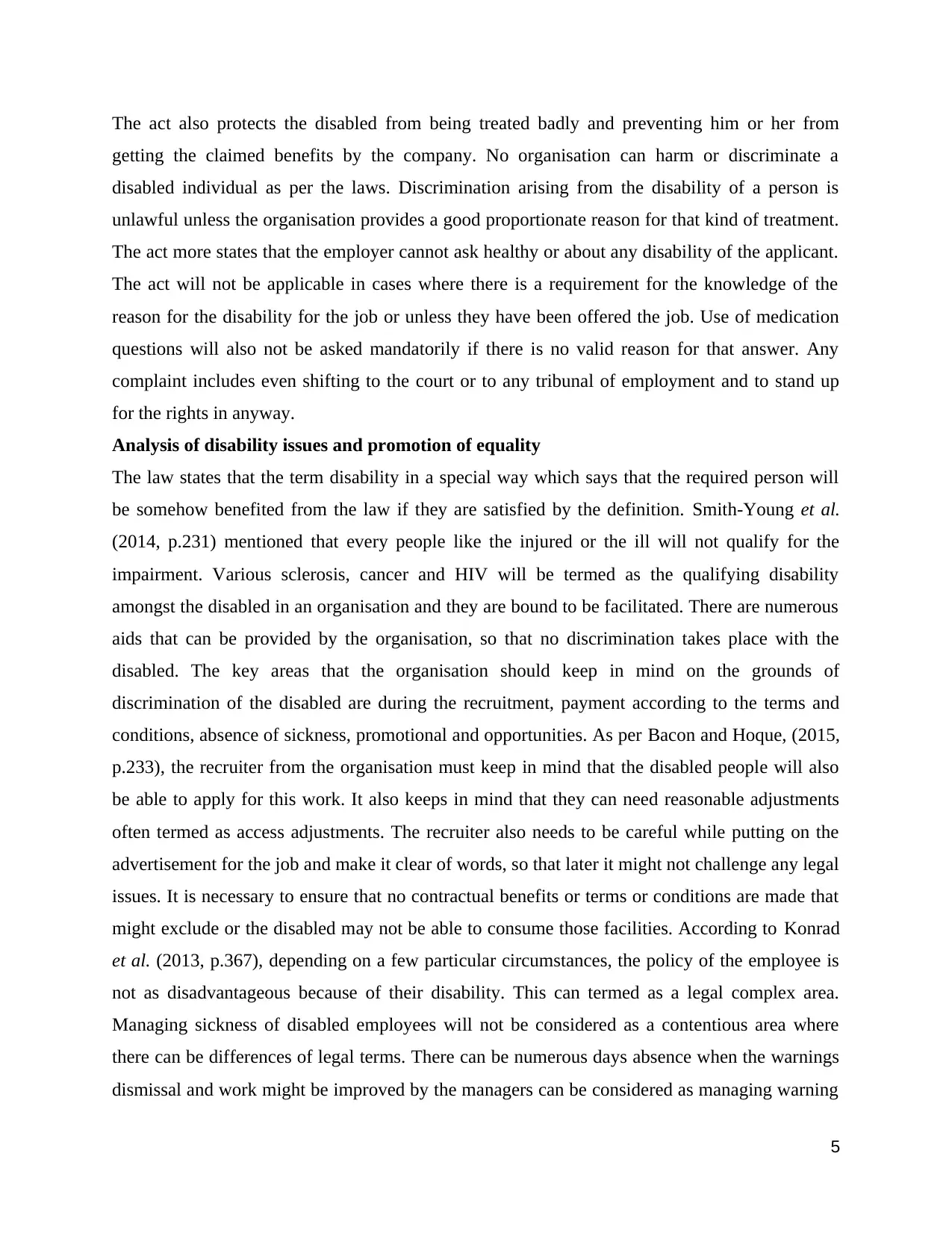
The act also protects the disabled from being treated badly and preventing him or her from
getting the claimed benefits by the company. No organisation can harm or discriminate a
disabled individual as per the laws. Discrimination arising from the disability of a person is
unlawful unless the organisation provides a good proportionate reason for that kind of treatment.
The act more states that the employer cannot ask healthy or about any disability of the applicant.
The act will not be applicable in cases where there is a requirement for the knowledge of the
reason for the disability for the job or unless they have been offered the job. Use of medication
questions will also not be asked mandatorily if there is no valid reason for that answer. Any
complaint includes even shifting to the court or to any tribunal of employment and to stand up
for the rights in anyway.
Analysis of disability issues and promotion of equality
The law states that the term disability in a special way which says that the required person will
be somehow benefited from the law if they are satisfied by the definition. Smith-Young et al.
(2014, p.231) mentioned that every people like the injured or the ill will not qualify for the
impairment. Various sclerosis, cancer and HIV will be termed as the qualifying disability
amongst the disabled in an organisation and they are bound to be facilitated. There are numerous
aids that can be provided by the organisation, so that no discrimination takes place with the
disabled. The key areas that the organisation should keep in mind on the grounds of
discrimination of the disabled are during the recruitment, payment according to the terms and
conditions, absence of sickness, promotional and opportunities. As per Bacon and Hoque, (2015,
p.233), the recruiter from the organisation must keep in mind that the disabled people will also
be able to apply for this work. It also keeps in mind that they can need reasonable adjustments
often termed as access adjustments. The recruiter also needs to be careful while putting on the
advertisement for the job and make it clear of words, so that later it might not challenge any legal
issues. It is necessary to ensure that no contractual benefits or terms or conditions are made that
might exclude or the disabled may not be able to consume those facilities. According to Konrad
et al. (2013, p.367), depending on a few particular circumstances, the policy of the employee is
not as disadvantageous because of their disability. This can termed as a legal complex area.
Managing sickness of disabled employees will not be considered as a contentious area where
there can be differences of legal terms. There can be numerous days absence when the warnings
dismissal and work might be improved by the managers can be considered as managing warning
5
getting the claimed benefits by the company. No organisation can harm or discriminate a
disabled individual as per the laws. Discrimination arising from the disability of a person is
unlawful unless the organisation provides a good proportionate reason for that kind of treatment.
The act more states that the employer cannot ask healthy or about any disability of the applicant.
The act will not be applicable in cases where there is a requirement for the knowledge of the
reason for the disability for the job or unless they have been offered the job. Use of medication
questions will also not be asked mandatorily if there is no valid reason for that answer. Any
complaint includes even shifting to the court or to any tribunal of employment and to stand up
for the rights in anyway.
Analysis of disability issues and promotion of equality
The law states that the term disability in a special way which says that the required person will
be somehow benefited from the law if they are satisfied by the definition. Smith-Young et al.
(2014, p.231) mentioned that every people like the injured or the ill will not qualify for the
impairment. Various sclerosis, cancer and HIV will be termed as the qualifying disability
amongst the disabled in an organisation and they are bound to be facilitated. There are numerous
aids that can be provided by the organisation, so that no discrimination takes place with the
disabled. The key areas that the organisation should keep in mind on the grounds of
discrimination of the disabled are during the recruitment, payment according to the terms and
conditions, absence of sickness, promotional and opportunities. As per Bacon and Hoque, (2015,
p.233), the recruiter from the organisation must keep in mind that the disabled people will also
be able to apply for this work. It also keeps in mind that they can need reasonable adjustments
often termed as access adjustments. The recruiter also needs to be careful while putting on the
advertisement for the job and make it clear of words, so that later it might not challenge any legal
issues. It is necessary to ensure that no contractual benefits or terms or conditions are made that
might exclude or the disabled may not be able to consume those facilities. According to Konrad
et al. (2013, p.367), depending on a few particular circumstances, the policy of the employee is
not as disadvantageous because of their disability. This can termed as a legal complex area.
Managing sickness of disabled employees will not be considered as a contentious area where
there can be differences of legal terms. There can be numerous days absence when the warnings
dismissal and work might be improved by the managers can be considered as managing warning
5
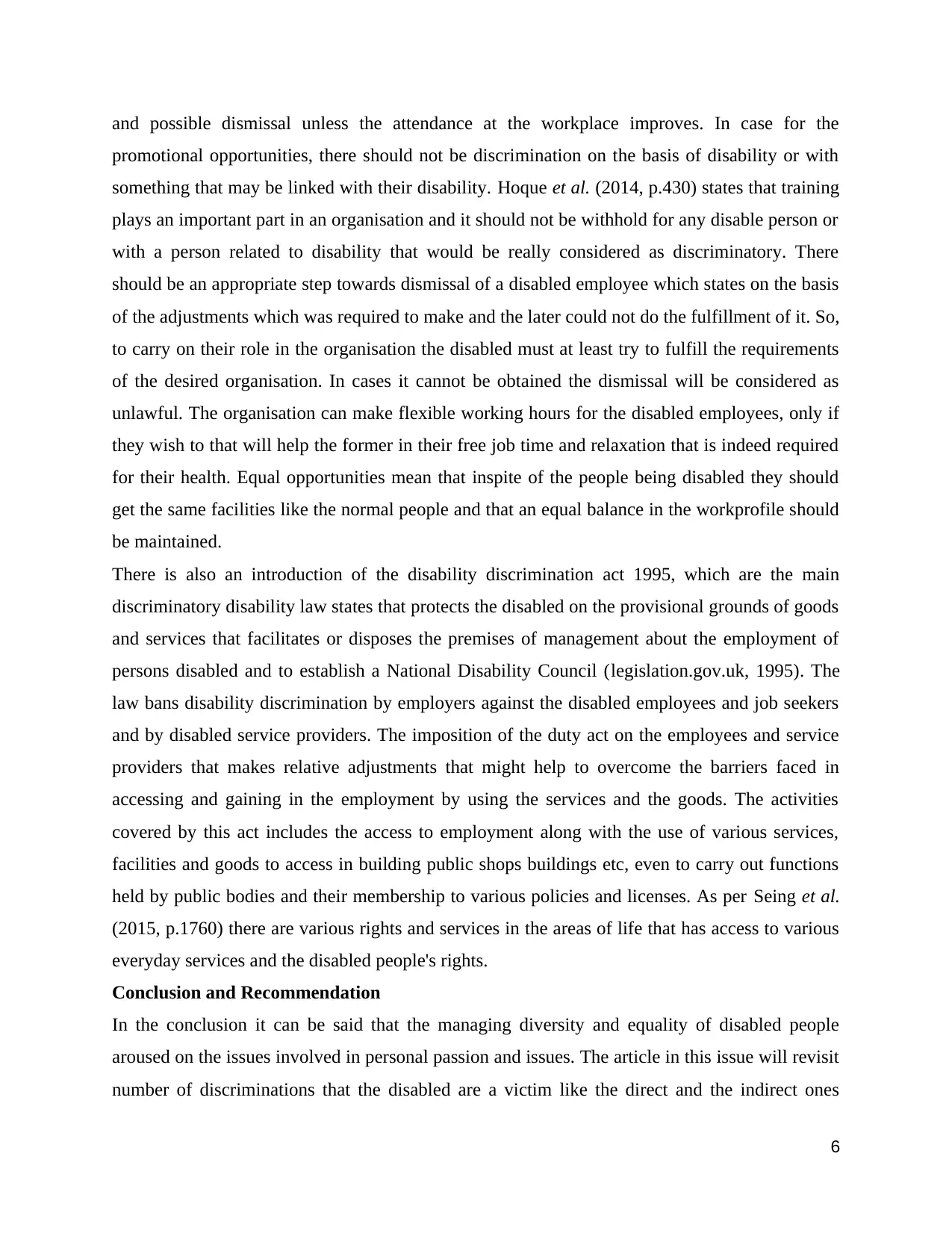
and possible dismissal unless the attendance at the workplace improves. In case for the
promotional opportunities, there should not be discrimination on the basis of disability or with
something that may be linked with their disability. Hoque et al. (2014, p.430) states that training
plays an important part in an organisation and it should not be withhold for any disable person or
with a person related to disability that would be really considered as discriminatory. There
should be an appropriate step towards dismissal of a disabled employee which states on the basis
of the adjustments which was required to make and the later could not do the fulfillment of it. So,
to carry on their role in the organisation the disabled must at least try to fulfill the requirements
of the desired organisation. In cases it cannot be obtained the dismissal will be considered as
unlawful. The organisation can make flexible working hours for the disabled employees, only if
they wish to that will help the former in their free job time and relaxation that is indeed required
for their health. Equal opportunities mean that inspite of the people being disabled they should
get the same facilities like the normal people and that an equal balance in the workprofile should
be maintained.
There is also an introduction of the disability discrimination act 1995, which are the main
discriminatory disability law states that protects the disabled on the provisional grounds of goods
and services that facilitates or disposes the premises of management about the employment of
persons disabled and to establish a National Disability Council (legislation.gov.uk, 1995). The
law bans disability discrimination by employers against the disabled employees and job seekers
and by disabled service providers. The imposition of the duty act on the employees and service
providers that makes relative adjustments that might help to overcome the barriers faced in
accessing and gaining in the employment by using the services and the goods. The activities
covered by this act includes the access to employment along with the use of various services,
facilities and goods to access in building public shops buildings etc, even to carry out functions
held by public bodies and their membership to various policies and licenses. As per Seing et al.
(2015, p.1760) there are various rights and services in the areas of life that has access to various
everyday services and the disabled people's rights.
Conclusion and Recommendation
In the conclusion it can be said that the managing diversity and equality of disabled people
aroused on the issues involved in personal passion and issues. The article in this issue will revisit
number of discriminations that the disabled are a victim like the direct and the indirect ones
6
promotional opportunities, there should not be discrimination on the basis of disability or with
something that may be linked with their disability. Hoque et al. (2014, p.430) states that training
plays an important part in an organisation and it should not be withhold for any disable person or
with a person related to disability that would be really considered as discriminatory. There
should be an appropriate step towards dismissal of a disabled employee which states on the basis
of the adjustments which was required to make and the later could not do the fulfillment of it. So,
to carry on their role in the organisation the disabled must at least try to fulfill the requirements
of the desired organisation. In cases it cannot be obtained the dismissal will be considered as
unlawful. The organisation can make flexible working hours for the disabled employees, only if
they wish to that will help the former in their free job time and relaxation that is indeed required
for their health. Equal opportunities mean that inspite of the people being disabled they should
get the same facilities like the normal people and that an equal balance in the workprofile should
be maintained.
There is also an introduction of the disability discrimination act 1995, which are the main
discriminatory disability law states that protects the disabled on the provisional grounds of goods
and services that facilitates or disposes the premises of management about the employment of
persons disabled and to establish a National Disability Council (legislation.gov.uk, 1995). The
law bans disability discrimination by employers against the disabled employees and job seekers
and by disabled service providers. The imposition of the duty act on the employees and service
providers that makes relative adjustments that might help to overcome the barriers faced in
accessing and gaining in the employment by using the services and the goods. The activities
covered by this act includes the access to employment along with the use of various services,
facilities and goods to access in building public shops buildings etc, even to carry out functions
held by public bodies and their membership to various policies and licenses. As per Seing et al.
(2015, p.1760) there are various rights and services in the areas of life that has access to various
everyday services and the disabled people's rights.
Conclusion and Recommendation
In the conclusion it can be said that the managing diversity and equality of disabled people
aroused on the issues involved in personal passion and issues. The article in this issue will revisit
number of discriminations that the disabled are a victim like the direct and the indirect ones
6
⊘ This is a preview!⊘
Do you want full access?
Subscribe today to unlock all pages.

Trusted by 1+ million students worldwide
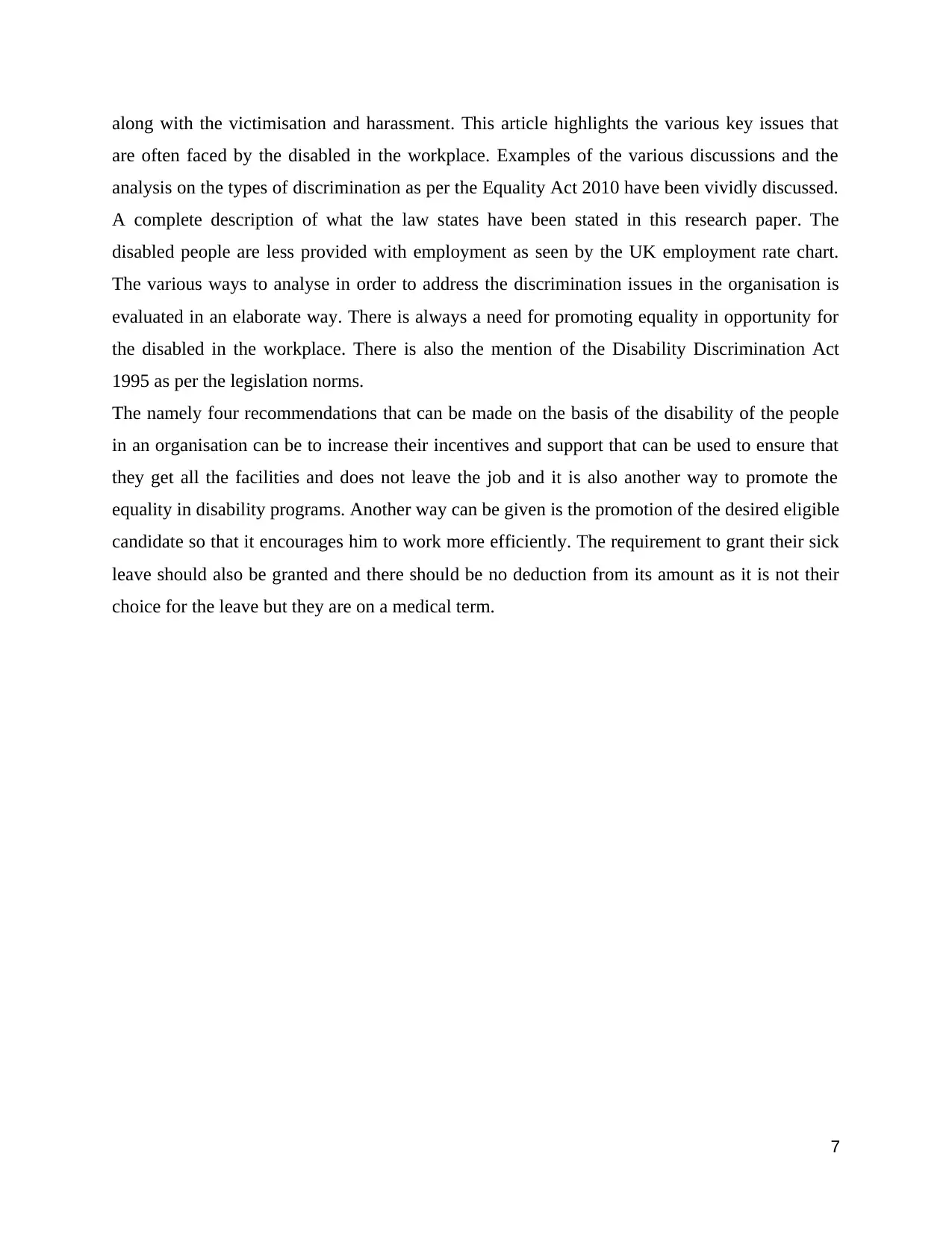
along with the victimisation and harassment. This article highlights the various key issues that
are often faced by the disabled in the workplace. Examples of the various discussions and the
analysis on the types of discrimination as per the Equality Act 2010 have been vividly discussed.
A complete description of what the law states have been stated in this research paper. The
disabled people are less provided with employment as seen by the UK employment rate chart.
The various ways to analyse in order to address the discrimination issues in the organisation is
evaluated in an elaborate way. There is always a need for promoting equality in opportunity for
the disabled in the workplace. There is also the mention of the Disability Discrimination Act
1995 as per the legislation norms.
The namely four recommendations that can be made on the basis of the disability of the people
in an organisation can be to increase their incentives and support that can be used to ensure that
they get all the facilities and does not leave the job and it is also another way to promote the
equality in disability programs. Another way can be given is the promotion of the desired eligible
candidate so that it encourages him to work more efficiently. The requirement to grant their sick
leave should also be granted and there should be no deduction from its amount as it is not their
choice for the leave but they are on a medical term.
7
are often faced by the disabled in the workplace. Examples of the various discussions and the
analysis on the types of discrimination as per the Equality Act 2010 have been vividly discussed.
A complete description of what the law states have been stated in this research paper. The
disabled people are less provided with employment as seen by the UK employment rate chart.
The various ways to analyse in order to address the discrimination issues in the organisation is
evaluated in an elaborate way. There is always a need for promoting equality in opportunity for
the disabled in the workplace. There is also the mention of the Disability Discrimination Act
1995 as per the legislation norms.
The namely four recommendations that can be made on the basis of the disability of the people
in an organisation can be to increase their incentives and support that can be used to ensure that
they get all the facilities and does not leave the job and it is also another way to promote the
equality in disability programs. Another way can be given is the promotion of the desired eligible
candidate so that it encourages him to work more efficiently. The requirement to grant their sick
leave should also be granted and there should be no deduction from its amount as it is not their
choice for the leave but they are on a medical term.
7
Paraphrase This Document
Need a fresh take? Get an instant paraphrase of this document with our AI Paraphraser
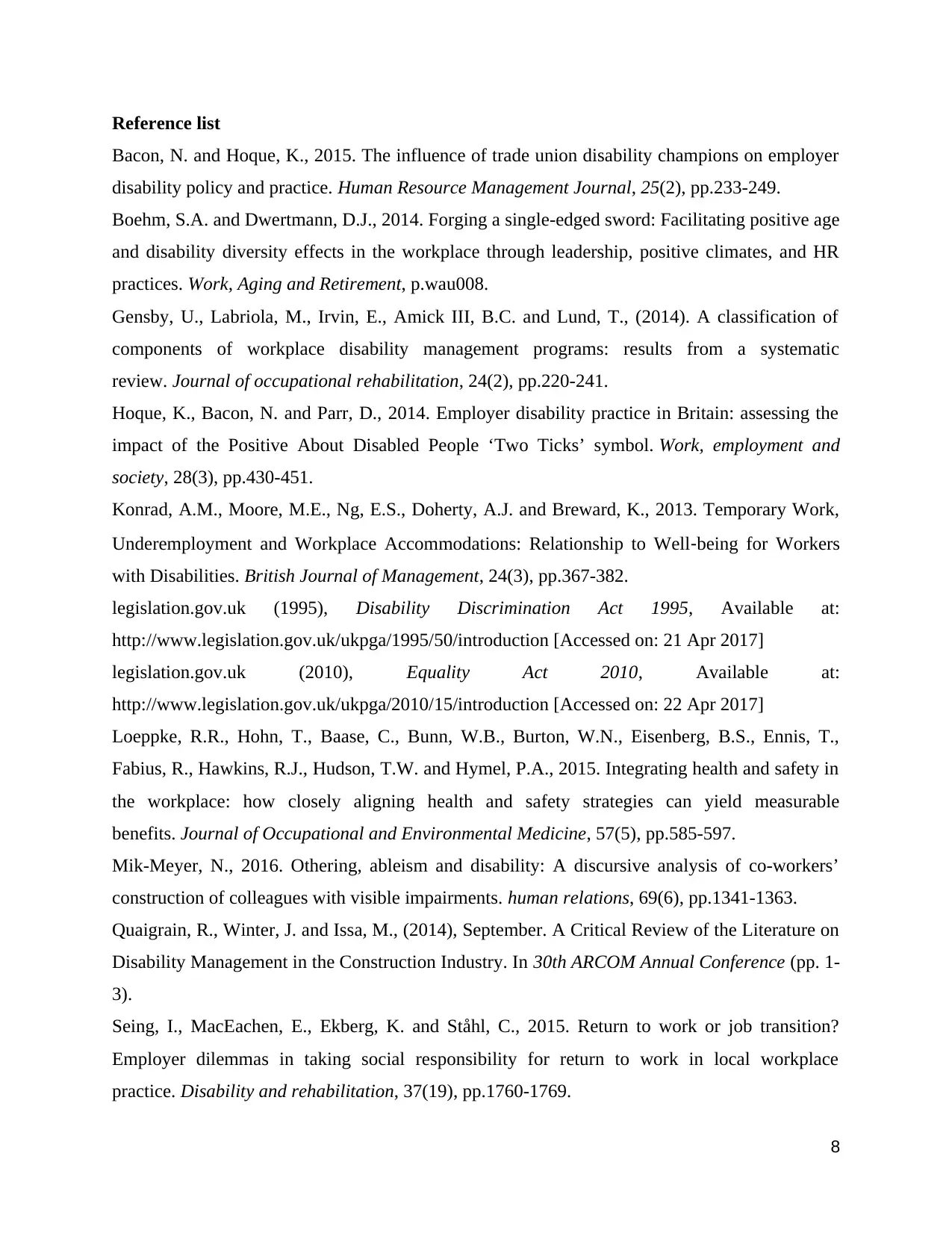
Reference list
Bacon, N. and Hoque, K., 2015. The influence of trade union disability champions on employer
disability policy and practice. Human Resource Management Journal, 25(2), pp.233-249.
Boehm, S.A. and Dwertmann, D.J., 2014. Forging a single-edged sword: Facilitating positive age
and disability diversity effects in the workplace through leadership, positive climates, and HR
practices. Work, Aging and Retirement, p.wau008.
Gensby, U., Labriola, M., Irvin, E., Amick III, B.C. and Lund, T., (2014). A classification of
components of workplace disability management programs: results from a systematic
review. Journal of occupational rehabilitation, 24(2), pp.220-241.
Hoque, K., Bacon, N. and Parr, D., 2014. Employer disability practice in Britain: assessing the
impact of the Positive About Disabled People ‘Two Ticks’ symbol. Work, employment and
society, 28(3), pp.430-451.
Konrad, A.M., Moore, M.E., Ng, E.S., Doherty, A.J. and Breward, K., 2013. Temporary Work,
Underemployment and Workplace Accommodations: Relationship to Well‐being for Workers
with Disabilities. British Journal of Management, 24(3), pp.367-382.
legislation.gov.uk (1995), Disability Discrimination Act 1995, Available at:
http://www.legislation.gov.uk/ukpga/1995/50/introduction [Accessed on: 21 Apr 2017]
legislation.gov.uk (2010), Equality Act 2010, Available at:
http://www.legislation.gov.uk/ukpga/2010/15/introduction [Accessed on: 22 Apr 2017]
Loeppke, R.R., Hohn, T., Baase, C., Bunn, W.B., Burton, W.N., Eisenberg, B.S., Ennis, T.,
Fabius, R., Hawkins, R.J., Hudson, T.W. and Hymel, P.A., 2015. Integrating health and safety in
the workplace: how closely aligning health and safety strategies can yield measurable
benefits. Journal of Occupational and Environmental Medicine, 57(5), pp.585-597.
Mik-Meyer, N., 2016. Othering, ableism and disability: A discursive analysis of co-workers’
construction of colleagues with visible impairments. human relations, 69(6), pp.1341-1363.
Quaigrain, R., Winter, J. and Issa, M., (2014), September. A Critical Review of the Literature on
Disability Management in the Construction Industry. In 30th ARCOM Annual Conference (pp. 1-
3).
Seing, I., MacEachen, E., Ekberg, K. and Ståhl, C., 2015. Return to work or job transition?
Employer dilemmas in taking social responsibility for return to work in local workplace
practice. Disability and rehabilitation, 37(19), pp.1760-1769.
8
Bacon, N. and Hoque, K., 2015. The influence of trade union disability champions on employer
disability policy and practice. Human Resource Management Journal, 25(2), pp.233-249.
Boehm, S.A. and Dwertmann, D.J., 2014. Forging a single-edged sword: Facilitating positive age
and disability diversity effects in the workplace through leadership, positive climates, and HR
practices. Work, Aging and Retirement, p.wau008.
Gensby, U., Labriola, M., Irvin, E., Amick III, B.C. and Lund, T., (2014). A classification of
components of workplace disability management programs: results from a systematic
review. Journal of occupational rehabilitation, 24(2), pp.220-241.
Hoque, K., Bacon, N. and Parr, D., 2014. Employer disability practice in Britain: assessing the
impact of the Positive About Disabled People ‘Two Ticks’ symbol. Work, employment and
society, 28(3), pp.430-451.
Konrad, A.M., Moore, M.E., Ng, E.S., Doherty, A.J. and Breward, K., 2013. Temporary Work,
Underemployment and Workplace Accommodations: Relationship to Well‐being for Workers
with Disabilities. British Journal of Management, 24(3), pp.367-382.
legislation.gov.uk (1995), Disability Discrimination Act 1995, Available at:
http://www.legislation.gov.uk/ukpga/1995/50/introduction [Accessed on: 21 Apr 2017]
legislation.gov.uk (2010), Equality Act 2010, Available at:
http://www.legislation.gov.uk/ukpga/2010/15/introduction [Accessed on: 22 Apr 2017]
Loeppke, R.R., Hohn, T., Baase, C., Bunn, W.B., Burton, W.N., Eisenberg, B.S., Ennis, T.,
Fabius, R., Hawkins, R.J., Hudson, T.W. and Hymel, P.A., 2015. Integrating health and safety in
the workplace: how closely aligning health and safety strategies can yield measurable
benefits. Journal of Occupational and Environmental Medicine, 57(5), pp.585-597.
Mik-Meyer, N., 2016. Othering, ableism and disability: A discursive analysis of co-workers’
construction of colleagues with visible impairments. human relations, 69(6), pp.1341-1363.
Quaigrain, R., Winter, J. and Issa, M., (2014), September. A Critical Review of the Literature on
Disability Management in the Construction Industry. In 30th ARCOM Annual Conference (pp. 1-
3).
Seing, I., MacEachen, E., Ekberg, K. and Ståhl, C., 2015. Return to work or job transition?
Employer dilemmas in taking social responsibility for return to work in local workplace
practice. Disability and rehabilitation, 37(19), pp.1760-1769.
8
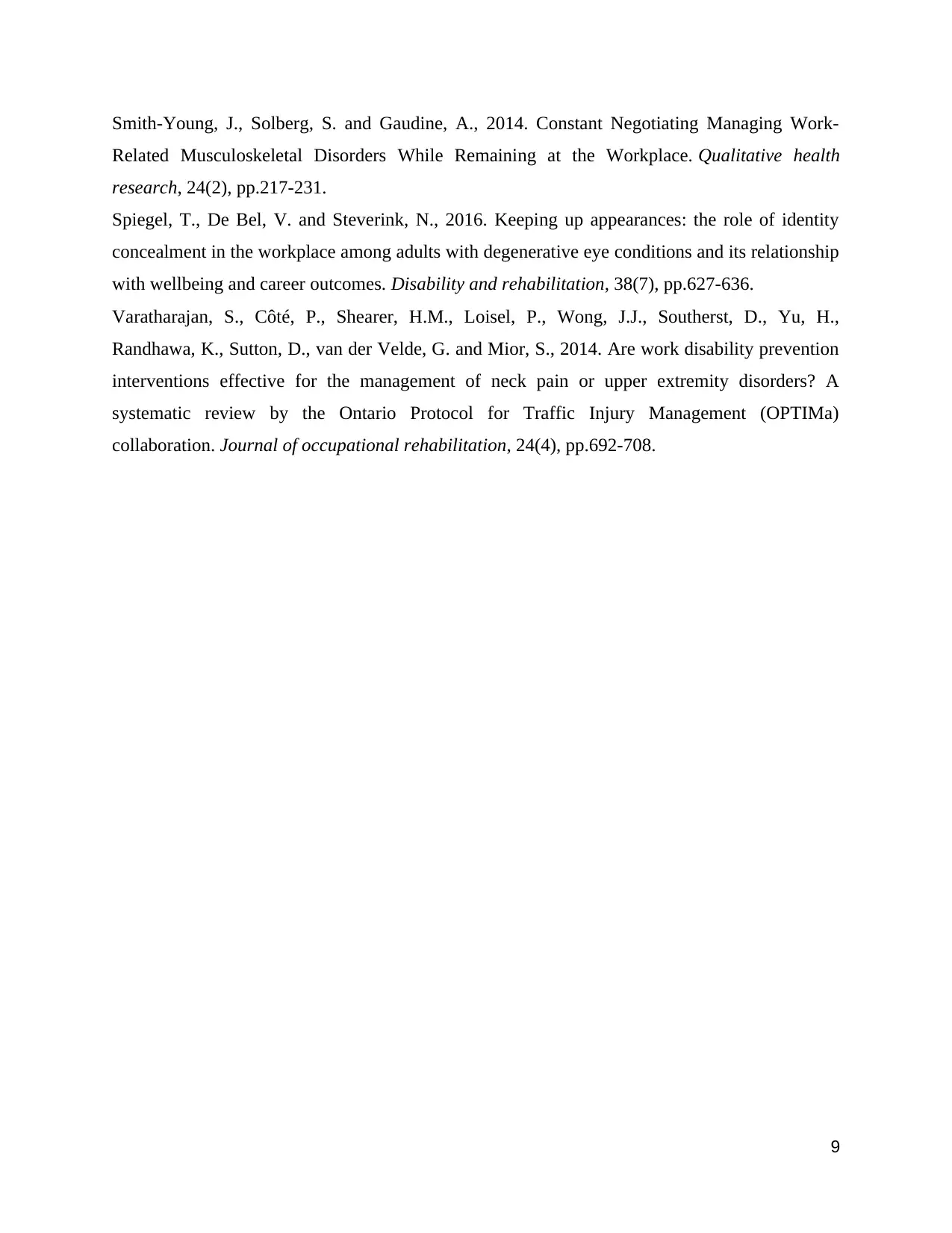
Smith-Young, J., Solberg, S. and Gaudine, A., 2014. Constant Negotiating Managing Work-
Related Musculoskeletal Disorders While Remaining at the Workplace. Qualitative health
research, 24(2), pp.217-231.
Spiegel, T., De Bel, V. and Steverink, N., 2016. Keeping up appearances: the role of identity
concealment in the workplace among adults with degenerative eye conditions and its relationship
with wellbeing and career outcomes. Disability and rehabilitation, 38(7), pp.627-636.
Varatharajan, S., Côté, P., Shearer, H.M., Loisel, P., Wong, J.J., Southerst, D., Yu, H.,
Randhawa, K., Sutton, D., van der Velde, G. and Mior, S., 2014. Are work disability prevention
interventions effective for the management of neck pain or upper extremity disorders? A
systematic review by the Ontario Protocol for Traffic Injury Management (OPTIMa)
collaboration. Journal of occupational rehabilitation, 24(4), pp.692-708.
9
Related Musculoskeletal Disorders While Remaining at the Workplace. Qualitative health
research, 24(2), pp.217-231.
Spiegel, T., De Bel, V. and Steverink, N., 2016. Keeping up appearances: the role of identity
concealment in the workplace among adults with degenerative eye conditions and its relationship
with wellbeing and career outcomes. Disability and rehabilitation, 38(7), pp.627-636.
Varatharajan, S., Côté, P., Shearer, H.M., Loisel, P., Wong, J.J., Southerst, D., Yu, H.,
Randhawa, K., Sutton, D., van der Velde, G. and Mior, S., 2014. Are work disability prevention
interventions effective for the management of neck pain or upper extremity disorders? A
systematic review by the Ontario Protocol for Traffic Injury Management (OPTIMa)
collaboration. Journal of occupational rehabilitation, 24(4), pp.692-708.
9
⊘ This is a preview!⊘
Do you want full access?
Subscribe today to unlock all pages.

Trusted by 1+ million students worldwide
1 out of 9
Related Documents
Your All-in-One AI-Powered Toolkit for Academic Success.
+13062052269
info@desklib.com
Available 24*7 on WhatsApp / Email
![[object Object]](/_next/static/media/star-bottom.7253800d.svg)
Unlock your academic potential
Copyright © 2020–2025 A2Z Services. All Rights Reserved. Developed and managed by ZUCOL.





